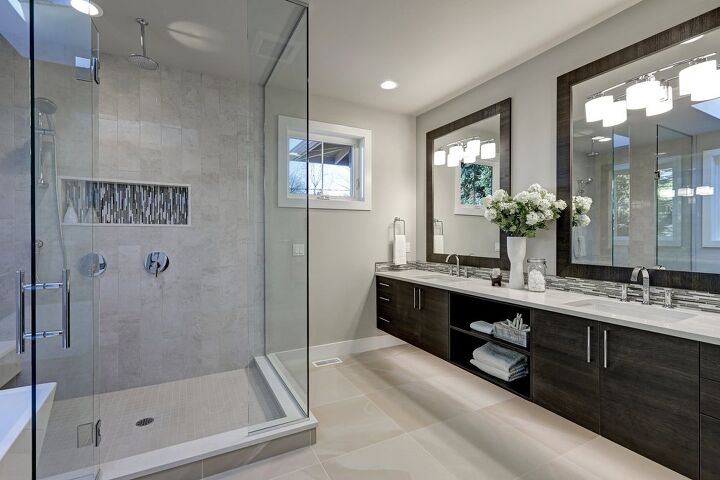What's The Ideal Shower Curb Height?

Shower curbs are such a fixture of the average full bathroom that it’s easy to ignore them even as you step over one. However, it is important to consider every aspect of a shower curb when you install or renovate a shower. So, what is the ideal shower curb height?
The ideal shower curb height is 2” above the top of the drain, or as short as 1 ¼” if you have a ¼” per foot slope. Shower curb height refers to the drop off between the top of the drain and the curb, and they cannot be higher than 9”. Showers with a big slant or slope require short curbs, and level showers require a taller curb.
Building codes require a minimum of 2” height if you have a curb, but curbless showers are a great alternative. Shower curbs can prevent water from pooling, splashing, or flooding your bathroom. Follow along as we take a look at the ideal shower curb height and see why it matters.
Do You Need to Hire Shower Installers?
Get free, zero-commitment quotes from pro contractors near you.

What is The Purpose of a Shower Curb?
The purpose of a shower curb is to capture the water that comes into the shower stall. If you didn’t install a shower curb, then all of that water falling on the floor of your shower would seep into the main room on the floor. This would eventually cause damage to your floor, not to mention the danger of slipping or falling as well.
Understanding the purpose of a shower curb is vital to keeping your bathroom area safe and free of water damage. Also, the shower curb lessens the chance for accidents to occur if water was to spill over to the ‘dry’ area of the room. However, you need to be careful of any potential obstructions getting into the drain. Since the shower curb holds everything on the shower floor, this means it also has dirt and debris.
Shower Curb Height
The minimum shower curb height is 2” above the top of the drain, but the height refers to the drop. Building codes require that 2” of drop between the shower curb and the top of the drain, but that doesn’t mean that you need to install a 2” curb. The curb itself could be as short as 1 ¼” if you have a ¼” per foot slope as long as it is 3 feet away from the drain which would make the drop 2”.
The shower curb height has as much to do with the slope as it does with the drain or curb itself. Building codes about shower curbs are strict due to the safety risks involved because shower curbs can prevent slips. A curb that is too tall, on the other hand, is just as dangerous as one that is too short and can cause you to trip in the shower.
After the average homeowner adjusts for slope, you can generally install a shower curb to be ¼” higher than the floor. Your shower curb is up to code as long as it is at least ¼” above the bathroom floor and has 2” drop to the shower floor drain. Building codes require the 2” drop off height because it can help catch the water that splashes and prevent an overflow.
Maximum Shower Curb Height
The maximum shower curb height is 9”, but even a 9” curb can cause homeowners to trip and is a safety risk. Some homeowners find the 2” minimum height to be too small, especially if there isn’t much slope, but 9” is arguably excessive. A 9” shower curb is nearly one foot tall depending on the slope, and that can be hard to clear for elderly homeowners or children.
The maximum curb height refers to the drop from off between the curb and the drain as well. A shower curb that has a 9” drop off from the drain can effectively prevent flooding, but it may not be ideal for safety purposes. Objects such as washcloths or empty shampoo bottles can easily clog a shower drain, and a tall shower curb ensures that the water won’t spill over onto the floor.
You need a taller shower curb if you have a level shower floor without much or any slope. However, you can get by with a short shower curb if you have a slanted floor as long as you have the minimum drop-off to the top of the drain.
What is the Width of a Shower Curb?
Shower curbs are generally 36” wide, but they can be they can measure up to 48” wide. The ideal shower curb width depends on your shower’s dimensions. Showers rarely measure smaller than 36” x 36”, but anything bigger than that can only get more comfortable.
A shower curb must match the size of your shower, so a 40” inch wide shower needs a 40” wide curb. The most narrow shower curb can be 30” wide because building codes prohibit showers smaller than 30” x 30”. Luckily, all that you need to do is refer to your shower’s dimensions and install a curb that matches the measurements.
Overhang
Overhang is another important factor, and it is ideal to install a shower curb overhang at least ½” wide to prevent flooding. However, building codes don’t require that you install a curb with an overhang and there are no strict rules about it. You can save yourself the trouble if you put in a shower curb with an overhang, especially if your shower is prone to splashing or flooding.
An overhang provides an extra level of protection if something blocks your drain and the water level rises. The extra protection that you get from an overhang is mostly useful if your water pressure is powerful and you have a strong showerhead. It may not be necessary to upgrade to an overhang, but it never hurts to install one when you build a new shower or renovate an old one.
Are Shower Curbs Required?
Building codes don’t require you to install a shower with a curb, but it is generally necessary. However, curbless showers are more popular than ever and they can add a stylish flair to your bathroom. It is ideal to install a linear drain in a curbless shower so that water doesn’t pool, spill out, or flood the bathroom.
The main concern with curbless showers is water damage, but that isn’t a problem if you utilize slope and a good drain. It costs an average of $3,750 to install a curbless shower, but it can cost over $5,000. You can essentially convert most showers into a curbless shower, but you may sacrifice privacy and spend a fortune.
Summing It Up
A shower curb must be 2” above the top of a drain according to the minimum requirements or U.S. building codes. Slope is the most important factor, and your shower curb can be as short as 1 ¼” if you have a slope of ¼” per foot. You can install a short shower curb if you have a steep slope, and level shower floors require a taller shower curb.
Shower curbs cannot exceed 9”, and tall curbs are necessary to prevent flooding and splashing in level showers. However, you aren’t required to install a shower with curbs, and curbless showers are quite popular. Linear drains are the best for curbless showers because they can quickly drain water even if there isn’t much slope.
You must comply with U.S. building codes and install a curb with a 2” drop off above to the drain if you choose curbs. Otherwise, simply install a curbless shower or renovate it to make it more accessible and circumvent the slope equation.
Related Guides

We are a team of passionate homeowners, home improvement pros, and DIY enthusiasts who enjoy sharing home improvement, housekeeping, decorating, and more with other homeowners! Whether you're looking for a step-by-step guide on fixing an appliance or the cost of installing a fence, we've here to help.
More by Upgraded Home Team



























